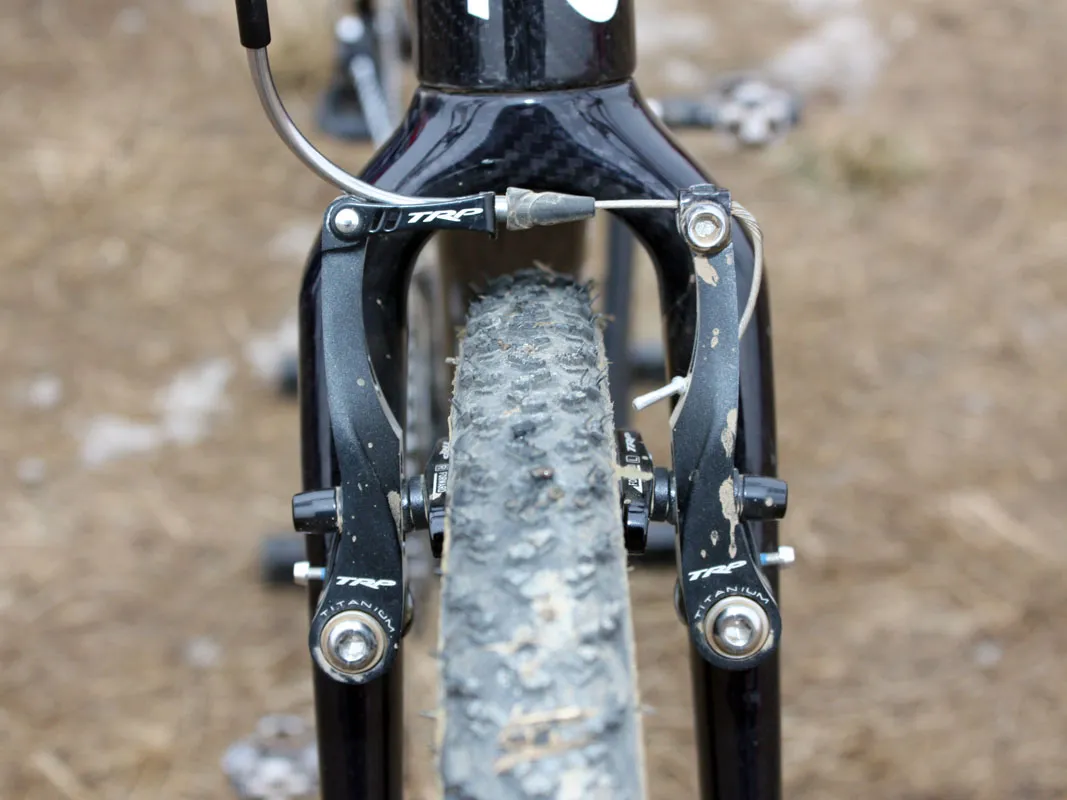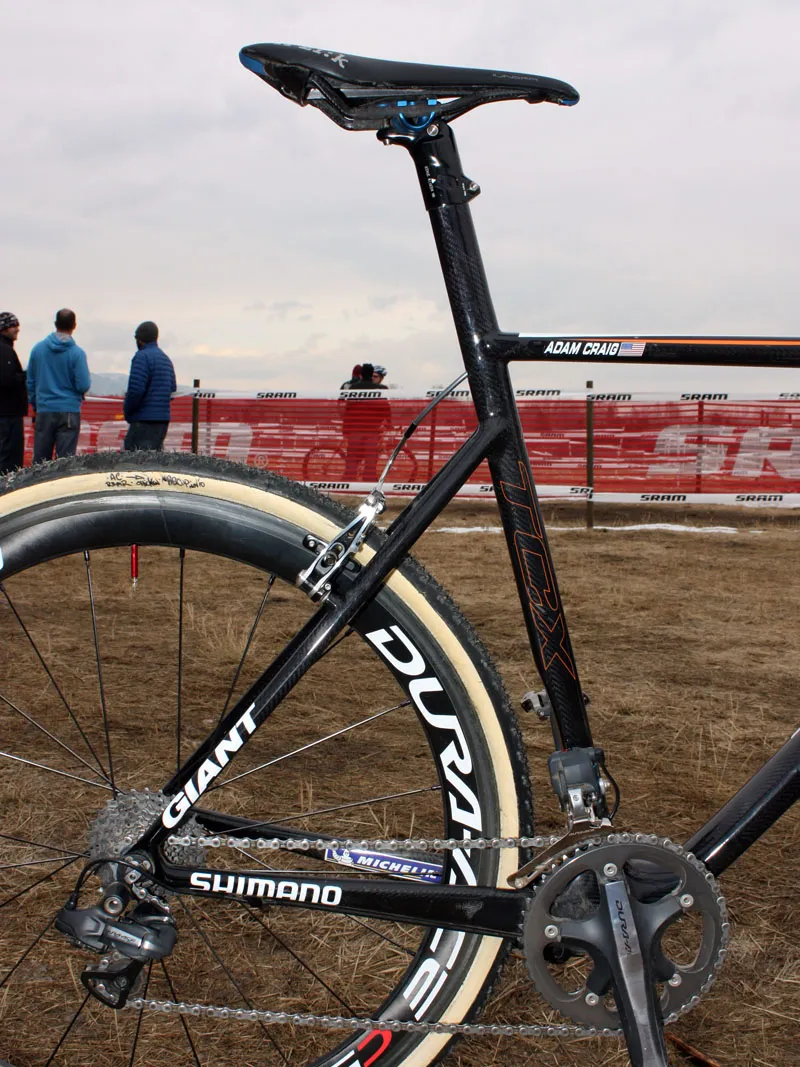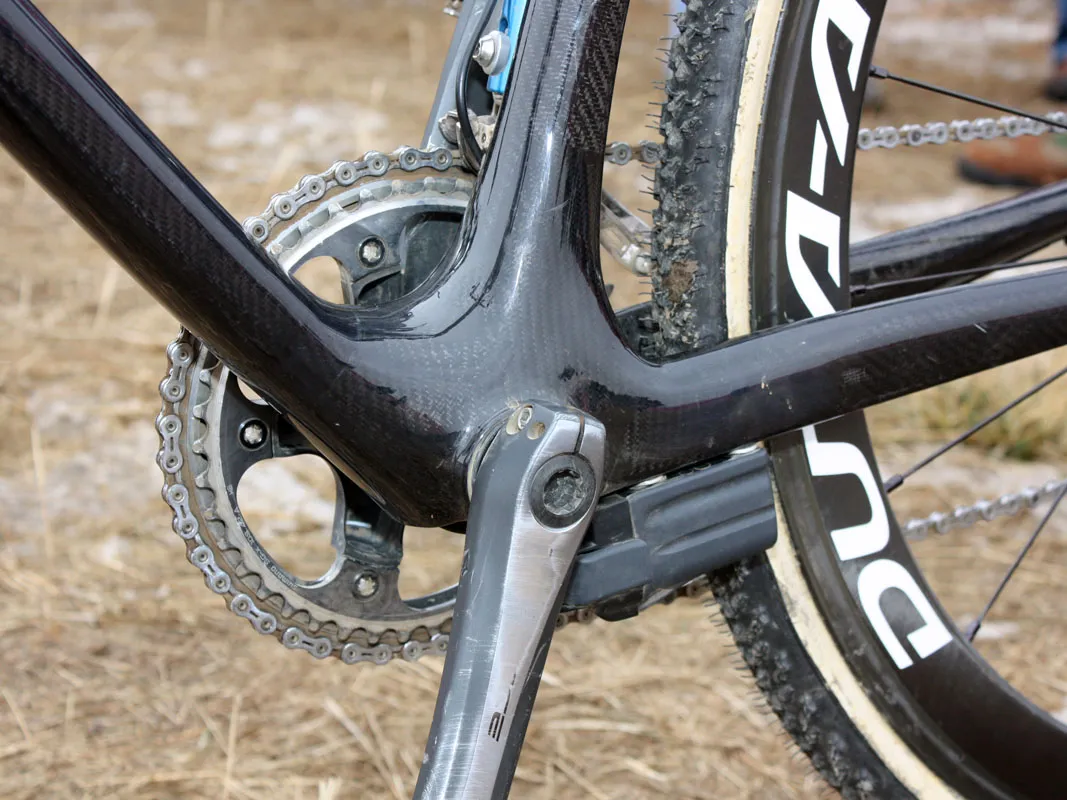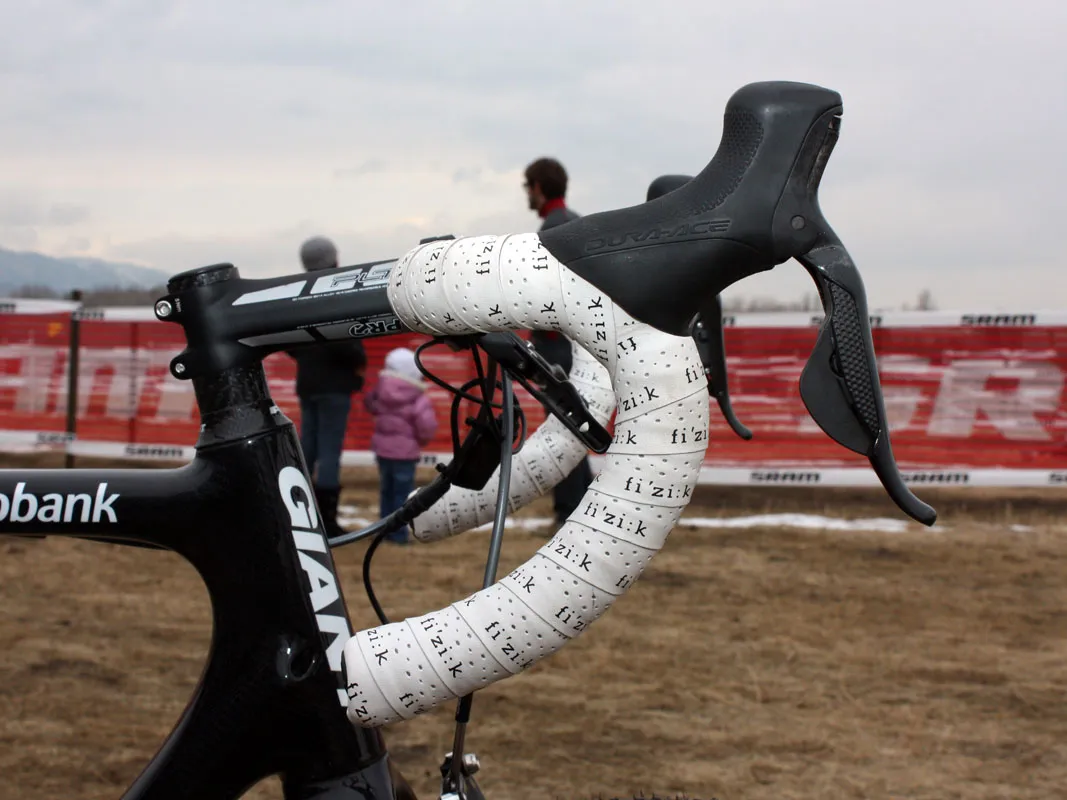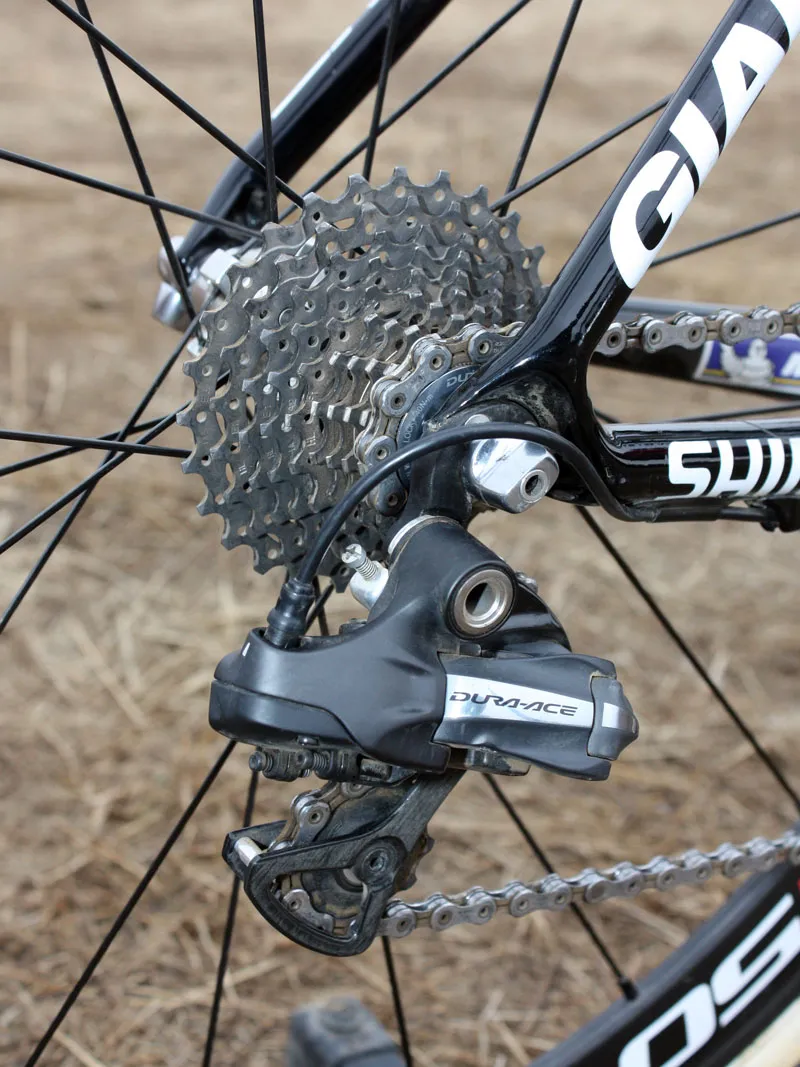American racer Adam Craig (Rabobank-Giant) is best known for his exploits on the domestic cross-country and Super D circuits but he's no slouch on a cyclo-cross bike, either. After years of slogging through the mud on an all-aluminum machine, he's now on Giant's latest TCX Advanced SL carbon superbike and isn't looking back.
In addition to being appreciably lighter than Craig's previous bike, modern features like the tapered front end, press-fit bottom bracket shell, and the larger and stiffer down tube that connects the two, make for a notably more responsive chassis, both in terms of drivetrain efficiency and handling precision.
Thanks to carbon fiber's more flexible shaping potential relative to aluminum, the frame designers were also able to build in much more mud clearance all around, plus clever internal cable routing and an integrated seatmast that's specifically tuned for comfort rather than stiffness.
"Oh, God," he said with a chuckle when asked to describe the differences hours before taking the start line at the New Belgium Cup in Fort Collins, Colorado aboard his new 7.83kg (17.26lb) rig. "The thing's light and rides awesome – it's super-smooth. The whole seatstay/top tube/seat tube junction area is a really good flex point and you feel that up through the ISP when you're seated. And then as soon as you're out of the saddle it's stiff. It's a rad bike."

According to Giant, offsetting the top tube and seatstays allows the seat tube to flex more when loaded
Craig admits that he didn't play much of a role in the bike's development – that was left to Rabobank's full-time 'cross racers over in Europe – saying he didn’t come into the process until prototypes were already built and just provided feedback. Even so, he says the overall feel and quick geometry are well suited to his style of racing.
"I didn't have a ton of input on it because I don't race 'cross full-time," he said. "I like to think I know what I want out of a 'cross bike – I want the bottom bracket low enough to corner well and a short rear-center to keep things tight and quick, and we were able to achieve that for sure."
Craig's choice of brakes highlights his hard-charging handling technique. Rather than opt for the more traditional wide-profile cantilever arms to save weight and gain mud clearance, Craig forgoes center-pull brakes altogether in favor of TRP's increasingly popular and far more powerful CX 9 short-arm linear-pull calipers plus supplemental top-mount levers to more closely emulate the feel of his mountain bike.

Given Adam Craig's mountain bike roots, it's perhaps no surprise to find a set of top-mount brake levers clamped on to his PRO bars
"When you actuate your brake lever, your bike stops – it's super=cool. It's hard to wrap my head around," he said in disbelief at what many other racers are all too willing to put up with. "Those brakes were worth their weight in gold last weekend in LA [where it was] kind of grippy but kind of slippery hardpack with a bunch of hard braking into corners and a bunch of needing to steer your bike. You'd lose the front wheel and you can trail a little rear brake to bring your front wheel back in. It's just basic bike riding techniques that I can finally use on my 'cross bike."
So why do most people still use traditional cantilevers or, even worse, wide-profile Euro-style brakes? Craig doesn't pull any punches in his reply. "Because most people suck at riding," he said, jokingly. "And they don't know any better. They think that the wide-profile Mafac thing is cool, which it was back in 1954 when they thought of them way back in the day."
Craig admits, though, that while most privateer racers in wetter climates do have to concern themselves with pad clearance in the mud, he not only often has the luxury of a pit bike but also a support mechanic to take care of both machines. Even so, he feels it makes more sense to choose your equipment based on the rule rather than the exception, and in many cases – at least in the US – that rule is dry and fast.
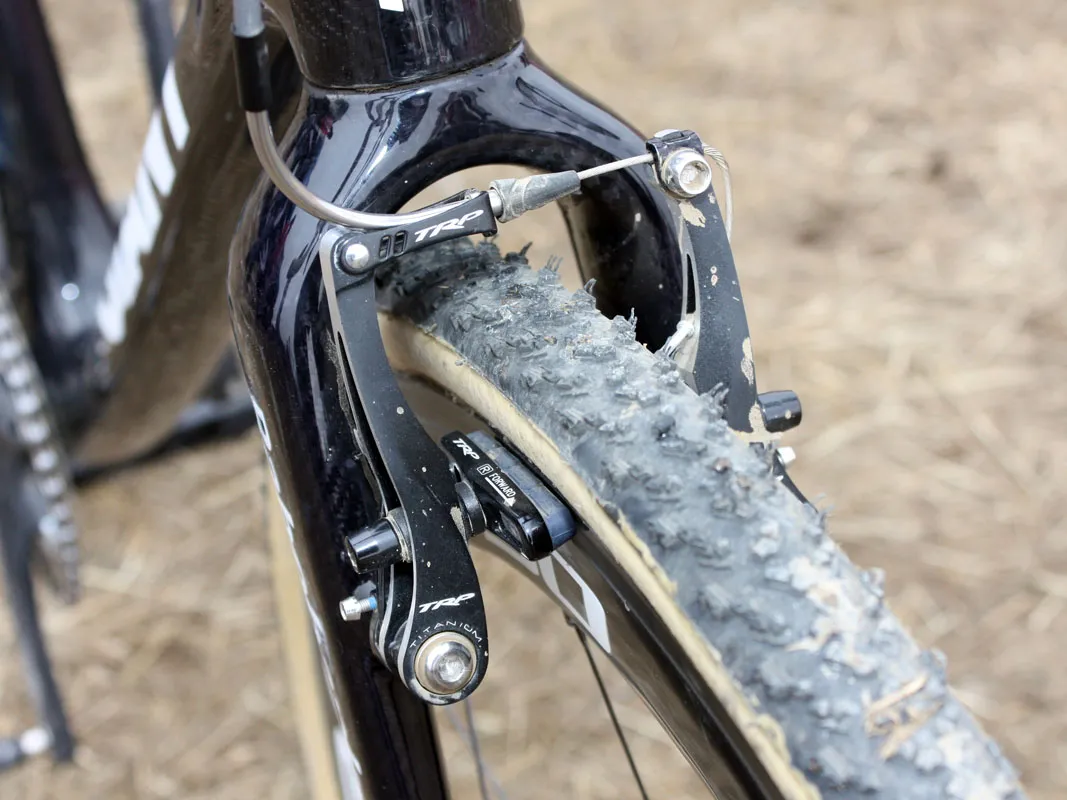
Craig is one of a growing number of top riders who have made the jump to TRP's high-power CX 9 linear-pull brakes
"I've got a guy in the pits so if my brakes are jammed up with mud I'll stop and get my other bike and ride that for a couple of laps, and then I'll have a new bike so it'll be a non-issue," he said. "[Fort Collins] has been the first muddy race of the year. When you're riding a motorcycle on a race track, you're either on the brakes or on the gas, and when you're on your bike you should be doing the same thing. You should be accelerating until you need to slow down at your braking point and with those brakes you can actually achieve that, so I'm fired up that Lance [Larrabee, at TRP USA] was able to bring that to market. They're awesome."
As a long-time Shimano-sponsored athlete, Craig's bike is so equipped nearly from head to toe, including a Dura-Ace Di2 group, 50mm-deep carbon tubular wheels – wrapped in custom Dugast tires with two varieties of grippy Michelin treads – the company's latest wide-platform XTR SPD pedals, and an aluminum bar and stem from PRO. Finishing things off are a carbon-railed Tundra saddle and bar tape from Fi'zi:k.

Craig normally rides on Michelin tires but this is the next best thing since the company don't make tubulars: Mud 2 tread on a supple 32mm-wide Dugast tubular casing. Craig calls the combination "super-awesome"
Shimano have touted Di2's quick and accurate shift performance since its introduction two years ago but Craig is quicker to laud its reliability and durability, even in adverse conditions. "That's just the next step for the zero-maintenance 'cross bike," he said. "The Di2 stuff is amazing. You set it up at the beginning of the year and, provided you don't bend your derailleur hanger in shipping, you forget about it for the rest of the year and maybe charge the battery if you remember to or maybe not – whatever.
"Initially I thought that the differentiation between the upshift and downshift paddle was a little close but now that I've gotten used to it it's so great. On a day like today where it's bumpy and cold, and your fingers are all numb anyway, it's so nice to just feel that tap and get a perfect shift every time. The motors are strong enough to work in the mud. I'm super-impressed."
Craig says his ultimate goal is to have a "zero-maintenance" 'cross bike with hydraulic discs added in, but accepts that will take a while despite the UCI's recent surprise ruling. But with well-protected, fully internal cable routing for the rear brake and that electronic transmission, he's not far off.

Craig says the Shimano Dura-Ace Di2 front derailleur has plenty of power to shift the chain even in heavy mud
Complete bike specifications
- Frame: Giant TCX Advanced SL, size M/L
- Fork: Giant TCX Advanced SL
- Headset: FSA Orbit IS, 1-1/8 to 1-1/4in tapered
- Stem: PRO PLT, 110mm x -6°
- Handlebar: PRO PLT, 44cm (c-c)
- Tape: Fi'zi:k bar:tape
- Front brake: TRP CX 9 w/ Shimano carbon-specific pads
- Rear brake: TRP CX 9 w/ Shimano carbon-specific pads
- Brake levers: Shimano Dura-Ace Di2 STI Dual Control ST-7950 w/ Salsa top-mount levers
- Front derailleur: Shimano Dura-Ace Di2 FD-7970-F
- Rear derailleur: Shimano Dura-Ace Di2 RD-7970
- Shift levers: Shimano Dura-Ace Di2 ST-7970
- Cassette: Shimano Dura-Ace CS-7900, 11-27T
- Chain: Shimano Dura-Ace CN-7900
- Crankset: Shimano Dura-Ace FC-7900, 175mm, 39/46T (Dura-Ace 7800 outer ring)
- Bottom bracket: Shimano Dura-Ace press-fit SMI-FC7900
- Pedals: Shimano XTR PD-M980
- Wheelset: Shimano Dura-Ace WH-7850-C50-TU
- Front tire: Custom Dugast tubular w/Michelin Mud 2 tread, 32mm
- Rear tire: Custom Dugast tubular w/Michelin Mud 2 tread, 32mm
- Saddle: Fi'zi'k Tundra Carbon
- Seatpost: integrated
Critical measurements
- Rider's height: 1.80m (5ft 11in)
- Rider's weight: 76.2kg (168lb)
- Saddle height, from BB (c-t): 775mm
- Saddle setback: 85mm
- Seat tube length, c-c: 540mm
- Tip of saddle nose to centre of bars (next to stem): 569mm
- Saddle-to-bar drop (vertical): 90mm
- Head tube length: 160mm
- Top tube length: 560mm (horizontal)
- Total bicycle weight: 7.83kg (17.26lb)




